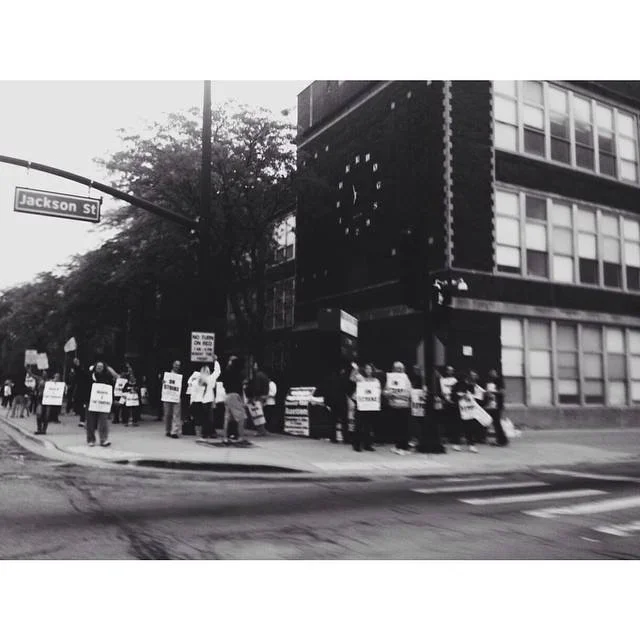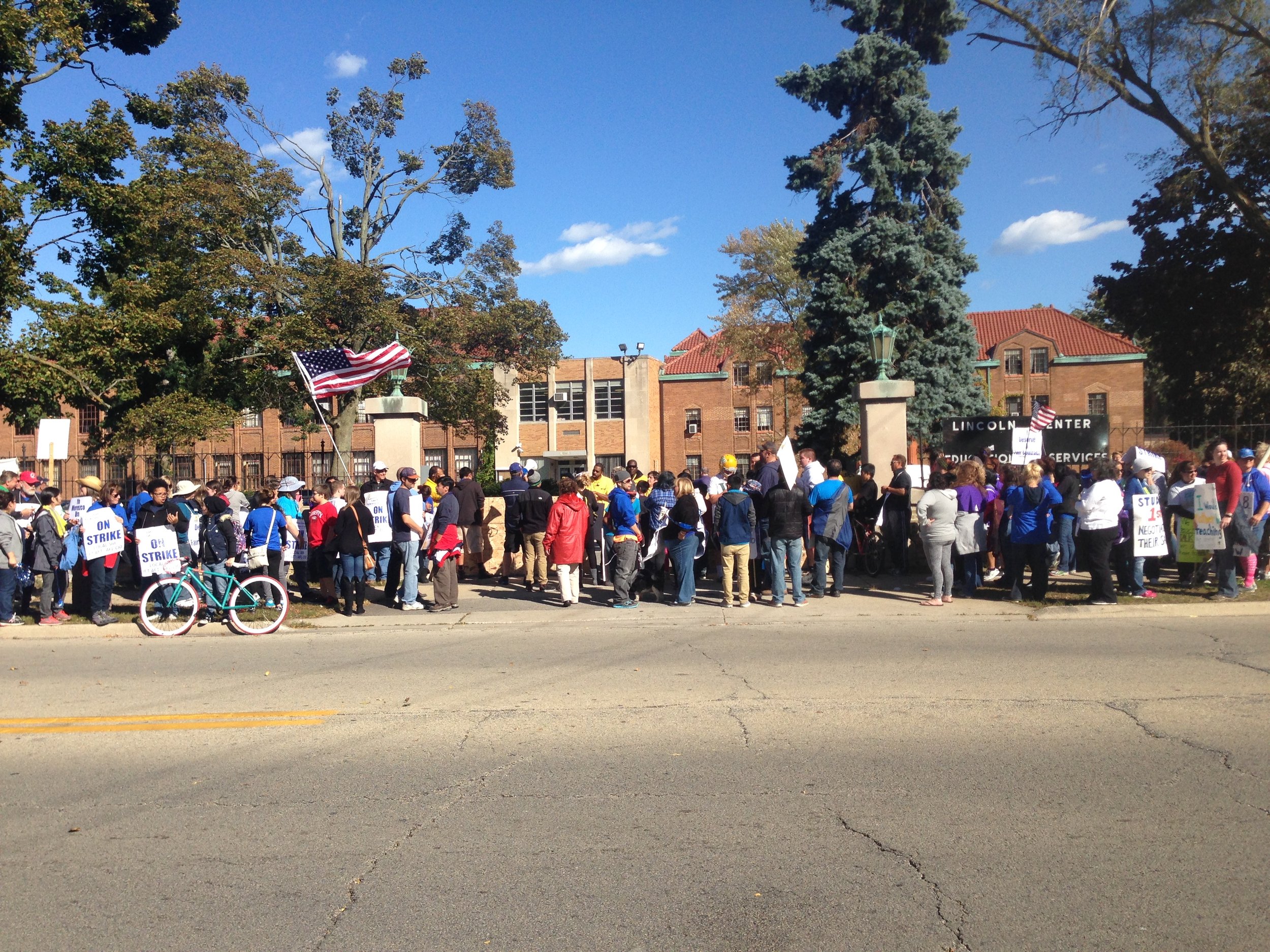Labor Day
WHY THIS MATTERS
The following stories show why unions and collective action are vital: they give workers a voice, protect essential rights, and strengthen entire communities against policies and practices that put survival at risk.
Echoes of the 2014 strike in Today’s Classrooms
Waukegan Public School District 60 is among the largest school districts in the state of Illinois. Fluctuating between fourteen and seventeen thousand students a year and over a thousand teachers, WPS60 is a Title 1 institution that touches the lives of nearly all 100,000 of Waukegan’s residents.
In the fall of 2014, the Waukegan Teachers’ Council and the Illinois Federation of Teachers Local 504, voted to go on strike for the first time in 30 years after negotiations with the school district for a new contract failed. While there were several contentious topics, discussions broke down primarily over salary and healthcare benefits. The district has a long history of salary freezes and distributing insufficient raises. In addition, teachers previously had their health insurance paid for by their public employers, the Waukegan School District, whereas under the new contract, teachers would have a small amount deducted from each paycheck, which effectively amounted to a de facto salary cut.
On October 2nd, teachers hit the picket lines across town. In retaliation for the strike, the district cut the healthcare benefits of all striking employees. This meant that teachers relying on their insurance to cover lifesaving procedures and medication, including two teachers who were battling cancer at the time, had to pay the full cost for these services.
The school district attempted to sway public opinion through automated phone messages to parents, tangled with misinformation, to pit families against their teachers. Despite their efforts, the strike had support from a majority of students and their families. There were personal concerns about athletics or their grades, sure, but most understood the actions taken by their teachers to fight for more rights and livable salaries.
Waukegan is a primarily low-income, working-class community, and many families rely on the school district to help with childcare during the day, as well as the meals served at every school, with three-quarters of the students on free or reduced-cost lunch programs. Luckily, Waukegan showed the resilience of its community as many institutions and organizations came together to help provide relief to families. The Waukegan Park District offered cheaper daycare for younger children and free gym access for older kids and teens. Both the park district and the Waukegan Library also offered free or affordable programs to keep children busy and engaged. To help meet food concerns, local food pantries and food drives gave out food to families that relied on those daytime meals.
This strike serves as a reminder that public education is not an abstract policy issue—it is deeply tied to the daily survival and well-being of working families. When teachers’ healthcare was threatened, and families had to rely on community organizations for food and childcare, it highlighted how schools are more than just places of learning. They are pillars of stability in communities where wages are stagnant, healthcare is unaffordable, and parents work multiple jobs to make ends meet.
This struggle has only intensified in the wake of the Trump administration’s efforts to dismantle the Department of Education, redirect funding, and roll back federal oversight, efforts which did not emerge in a vacuum. Policies that weaken protections for low-income students, strip resources from public schools, and shift funding toward privatization only exacerbate the very inequities that districts like Waukegan face. Federal initiatives like Race to the Top tied funding to test scores and incentivized districts to open charter schools, often at the expense of traditional public schools, eroding trust. In communities like Waukegan, this fostered a climate where public education was painted as inefficient and resistant to reform, while charter alternatives were positioned as innovative solutions despite their many flaws.
Against this backdrop, the strike became weaponized by district leaders and some policymakers to fuel anti-teacher and anti-public school sentiment, framing educators’ demands for fair pay and healthcare as selfish obstructions to “progress.” When teachers organize for better conditions, they are cast as the problem, while systemic underfunding and inequity are ignored. The strike exposed the fragility of public schools in low-income communities and revealed how quickly crises are exploited to justify dismantling them further. Just as in 2014, when families had to step in to fill the gaps left by the district’s decisions, today communities across the country are being asked to shoulder the burden of systemic disinvestment. In this way, the Waukegan strike is not just a local history, but a warning about the broader dismantling of public education in America which foreshadowed the national crisis we face now: whether public education remains a collective commitment to equity, where schools are treated as public goods meant to serve all, or schools become another institution hollowed out by political agendas and austerity measures.
The Current State of Walgreens Pharmacies and their Workers
Walgreens, the second largest pharmacy chain in the United States, was founded in Chicago, and is currently headquartered in Deerfield, on the southern edge of Lake County.
Having scheduled the closure of 1,200 stores last year, Walgreens seems intent on making life more difficult for people seeking medications. With CVS taking a similar approach and independent pharmacies being pushed out of business by a lack of cost reimbursement from insurance companies, people are left with fewer options and higher prices, forced to choose between near-monopolies.
But what about the employees? To gain more insight into current working conditions inside Walgreens, we interviewed a pharmacist with over a decade of experience at a local store, on the forefront of the chain’s daily operations. They wish to remain anonymous.
LFP: Are there any obstacles to customers receiving the pharmaceutical help they need when they need it? If so, what are they, and how do you think those issues could be fixed?
Pharmacist: They’re not providing enough training to the new pharmacy technicians. They know nothing and often can do nothing other than work the registers, let alone deal with intimidating customers. Oftentimes there are only around five people present who are fully competent running the whole pharmacy. The standards for getting certified as technicians have gone down to the point that the only real criteria is having enough money for tuition.
Without the extra manpower, we have no way to contact customers about drug shortages, and so they inevitably get upset. The workers should be Walgreens’ first priority; they’re essential. They need to make the job worth it by prioritizing our mental health to avoid understaffing. That’s true of all retail work.
LFP: Do you feel you are compensated appropriately for your labor?
Pharmacist: We are extremely underpaid, without any raises to compensate for inflation. I’m wondering if that’s illegal. Over the course of eight years, the pharmacy techs working with me have only gotten a pay increase of $1.29 an hour. They get paid less than babysitters in the Chicagoland area, making less than $20 per hour. If pharmacists and pharmacy technicians were paid better, there wouldn’t be such high turnover. New hires are screwed, and often leave almost immediately, since the rewards for the job aren’t there. No serious adult will take a technician job with all this, and that’s not even mentioning the people with mental illness or the ones with severe entitlement that we have to deal with. We’re tired of the disrespect.
LFP: How has Walgreens corporate changed your job duties over time?
Pharmacist: They have this system where managers offsite get paid to regularly make PCP calls to check in on customers the week after receiving their medication. Nobody actually likes getting these PCP calls. The people who make those calls are all worthless and should be fired.
When they visit the store, all they do is make demands, like to push for more vaccinations because those bring in more money. They never listen to us. I suspect they’re also testing the use of AI to take over some of what the technicians are doing, but that won’t help when it comes to making irate customers happy. They suck, and I’m retiring soon.
LFP: Sycamore Partners, a private equity company with a track record of managing companies into bankruptcies and facilitating OSHA violations at stores such as Staples, is set to fully acquire Walgreens for ten billion dollars by the end of this year. What changes do you think might come about at Walgreens stores as a result?
Pharmacist: I’ve heard, and it’s not good. They’ll sell stores for parts, especially the ones primarily catering to people on Medicaid, which are loss leaders. I’m a pessimist. The OSHA issues especially are a problem, given what we do. Employees at the larger stores will probably be safe, since we’re needed, but middle managers will likely be laid off. I don’t know, we’ll see. I just don’t like the corporate model in general.
LFP: Are there any efforts being made by your coworkers to organize a union? Why or why not?
Pharmacist: We actually already have a union. Chicago and Boston are the two cities in the US with Walgreens unions. I think they botched our contract negotiations recently, but they helped at one point. Now there aren’t enough members, and even with our 1% dues, we have nothing to show for it after seven years, especially as the cost of living keeps rising. I’m not super familiar with the politics of it, but I do know that we’re being taken advantage of by Walgreens; there’s no work/life balance. I can’t leave and start over at the entry level somewhere else because I need the consistent schedule. The same is true for everyone with families. their union-busting games, we will have an opportunity to combine the classes into a single Lake County Health Department employee union. While the state might recognize two classes of employees, we understand that this is a false division and that we are all workers who want a better life for ourselves and that only together can we win that fight.


